Random Reviews: The Complete Jon Sable, Freelance (vol. 1) Review
These issues introduce a unique 1980s vigilante, a character who provides hurt and heart in equal measure
—by Nathan on May 26, 2025—
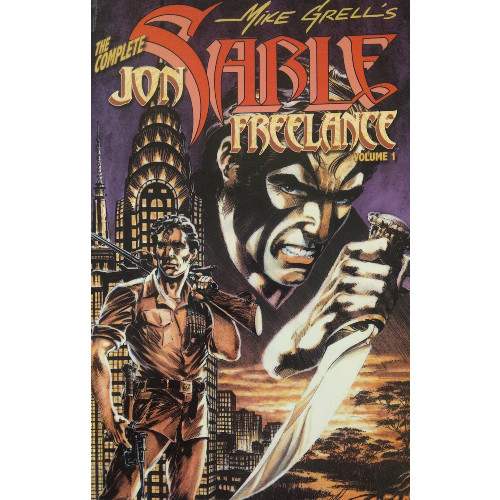
At the company I work for, we employ a group of individuals outside our employee pool to do a bevy of different tasks for us. These folks are contracted and paid for the services they provide. I'm actually the guy who communicates with several of them on behalf of other employees, serving as a middleman and making sure the correct documents are sent and the correct invoices are entered.
We call these people "freelancers."
They don't do what Jon Sable does.
The brainchild of Green Arrow: The Longbow Hunters writer/artist Mike Grell, Jon Sable was an early 80s independent comic series published by First Comics, the same company which absorbed Mike Baron's Nexus and where Baron created Wisconsin superhero Badger. Jon Sable was one of First Comics' first comics and was completely creator-owned, marking a somewhat shifting trend in the industry to allow creators more control over their work and give them better financial incentives (I say "somewhat" because bigger companies seemed stingier–look no further than seven artists leaving Marvel in the early 90s to form their own company as proof of that). As I've gained more interest in 80s independent narratives over the last year or two, reviewing the first issues of Nexus along with Art Spiegeman's Maus, I've kept an eye out for other stories. Since Longbow Hunters is one of my favorite DC limited series from the 80s, and because I recently reviewed some of Grell's follow up Green Arrow work as well, I wanted to see what else the writer/artist had worked on…and found Jon Sable.
Which, hey, is pretty impressive. This guy's an Olympic-level athlete and world-renowned hunter/tracker; not just anyone can find him, okay?
Grell had worked with DC in the 70s, penciling stories for Aquaman, Legion of Super-Heroes, and Green Arrow, among other characters, and creating Warlord for the company. Between that first stint and his post-Crisis work on Green Arrow, Grell found a home in the independent creator sphere. Out of that sphere came Jon Sable, Freelance.
Our freelancers copyedit and proofread books. Jon…well, he's actually not as distant from the publishing sphere as one might think, as we shall see, but he's mostly interested in writing conclusions for dangerous, violent people before they edit lives with the swift stroke of a bullet.
The Complete Job Sable, Freelancer (vol. 1)
Writer: Mike Grell
Penciler: Mike Grell
Inker: Mike Grell
Colorists: Janice Cohen and Bruce Patterson
Letterer: Peter Iro
Issues: Jon Sable, Freelance #1-6
Volume Publication Date: April 2005
Issue Publication Dates: June 1983-November 1983
Publisher: First Comics (original issues), IDW (volume)
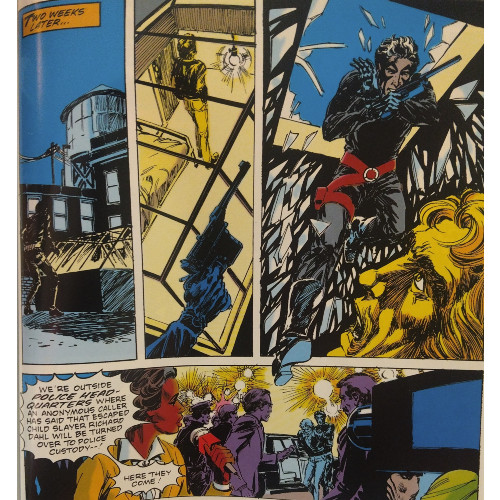
A little bit of poking around online revealed to me that Jon Sable is acclaimed as an independently-owned comic series that helped usher in the grim and gritty sensibilities that later 80s and 90s comics were fraught with, to the point of gluttony in the case of the 90s. But despite the later overindulgence, earlier 80s comics were shifting in tone and maturity–comics of this era can't be credited completely with that shift (arguments can be made that some 70s work heralded the turn towards darker storytelling trends), but Jon Sable belonged to a group of historic comics marking a maturation in narrative discernment. We're talking stuff that predated The Dark Knight Returns and Watchmen. I already referenced Maus, but how about Jim Starlin's captivating The Death of Captain Marvel or Chris Claremont and John Byrne's "The Dark Phoenix Saga"? Well-written, fantastically illustrated narratives that pushed the kinds of stories the medium was allowed to tell...and published at the dawn of the 80s, not smack-dab in the middle.
But most of those examples exist within the larger sphere of superhero comics, an overwhelmingly popular trend. Today, we're stepping outside the capes and cowls universes into a world that's more grounded, that looks more like the place where we live. In Jon Sable's world, like in ours, an assassin tries to kill President Ronald Regan (this guy completely misses, however). In his world, Jon competes in the 1972 Summer Olympics in Munich and is nearby when the Israeli team is taken hostage; it's indicated he is, in some way, inspired by the evil done that day to pursue a greater cause than winning gold medals. Jon doesn't go after world-dominating overlords or alien warriors but poachers and mercenaries. With a little face paint and his trusty Mauser pistol, Jon hunts his prey like the skilled tracker he is, preventing assassinations by killing bad guys first.
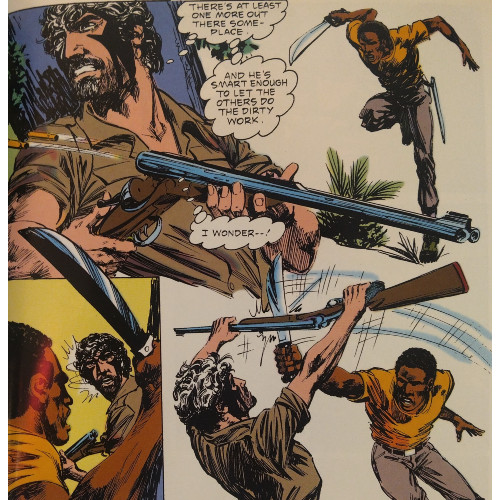
If you're looking for a comparison to be made between Sable and vigilantes such as the Punisher, don't get lost in the searching. Grell's anti-hero is a mercenary for money, driven by making a living as much as he is by any sense of justice or righteousness through violent means. He makes things right, sure–one lady pays him to bring her father's killer to justice–but a price is attached. And, yes, Sable's tragic backstory involves the loss of a wife and children, much like the aforementioned Frank Castle, but Sable isn't out fighting a one-man war on crime. He gets revenge on the mooks who murder his family, but his purpose is in the job title: "freelancer." He's a for-hire killer.
Grell skirts around most of the tired "killing is bad" arguments found in mainstream comics, and he manages to get away with it too! First Comics was an independent publisher (it still is, but the current incarnation is their second shot at the publishing game after initially closing in 1992), and you get a real sense Grell doesn't have to play along with the same moralities found in Marvel or DC books. No boy scouts here, just a dissenting cop who doesn't appreciate Sable's brand of vigilantism. But Grell doesn't make a huge deal out of the whole morality of the idea. Sable never once questions tracking down the men who murder his family, and you as the reader aren't necessarily supposed to either. This is who the character is, this is what he knows and what he does.
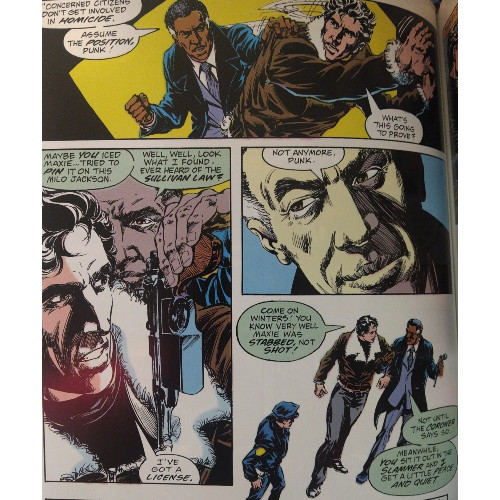
Most of the volume details a four-part origin story after Grell uses the series' first two issues to establish Sable's character. It's an interesting move, throwing in such a detailed narrative after debuting the series and unpacking so much of what makes the character tick instead of leaving Sable an enigmatic mercenary for slightly longer. I feel this is, largely, the right way for Grell to have gone–our first two issues lay the foundation for Sable's character, along with that of his alter ego, B.B. Flemm, and the remainder dive into why Sable has become this feared vigilante/mercenary. Grell has a good handle on the details–B.B. Flemm, the pseudonym Sable devises for himself, is a children's fiction author, inspired by the stories Sable told his children while they were alive; Sable's athleticism is shown and his earlier career is teased prior to the origin, setting up the necessary developments Grell discusses at length.
The "children's author" angle struck me as pleasantly odd at first, and on a second read, I became more enamored with the concept. The alter ego allows Jon to display a softer side of himself, one which is driven by greed (so the narrative says) but also feels like a loving tribute by a father to the children he lost. It's also an intriguing take on the identity concept–the violent vigilante is Jon's true face, even when obscured by face paint. The blond hair, the mustache, and the glasses he wears to interviews and book signings as Flemm–very begrudgingly, we're made aware–is the real disguise, allowing Sable to present himself as a normal person when he isn't following his true self, jumping between rooftops or navigating the jungle.
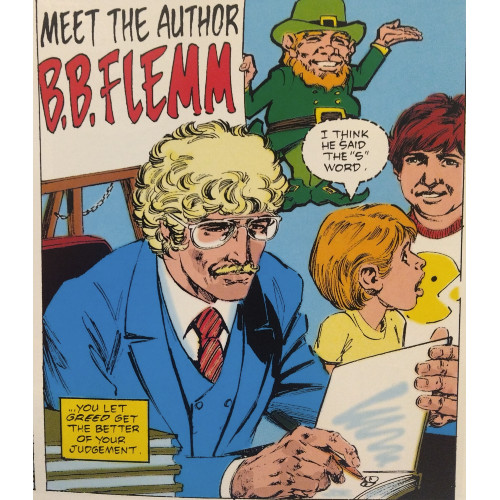
Sable's backstory is read in manuscript form by an important supporting cast member, her experience resembling (and hopefully reflecting) our own emotional shift as the narrative unfolds. If anything, the origin can, like some of the animals Sable tries to save from poaching, get a little long in the tusk. It's 108 pages total, per the volume's back cover copy, and though a good chunk of the story is integral to determining who Sable is a person, a few sequences late in the game feel somewhat indulgent on Grell's behalf. One incident involving Sable and a band of mercenaries rescuing a couple hoity toity folks using a hot air balloon is very cool in concept, but it contains too much ballast and drags that particular section along. The sequence feels like it would've been better placed as a separate issue, not as a tacked on, almost afterthought anecdote contained in the origin telling.
Otherwise, Grell creates for Sable a balanced introduction, weaving together violent action with softer touches of characterization to showcase his transformation from Olympian athlete, to husband and father, to coldblooded mercenary and children's author. Grell makes you believe in that transition–I never questioned the change, perhaps only mourning it a little. It's a very concrete, knowable world that Jon Sable inhabits, one where presidents are targeted, real world acts of terrorism play out as they did in ours, and families wind up on the receiving end of vengefully fired bullets. Jon doesn't don a padded suit with a skull-and-crossbones insignia and grab a whole armory of guns to wipe out the New York underworld in response. He has his little gun, and his face paint, and when he isn't hunting criminals, he writes about leprechauns living in Central Park. Quite the combination of characteristics for our mercenary/children's author, and despite the seeming disparity, Grell makes it work. You might disagree with his methods, but unlike some other vigilantes, Sable is mostly stable, and I don't just mean because his name contains most of the same letters.